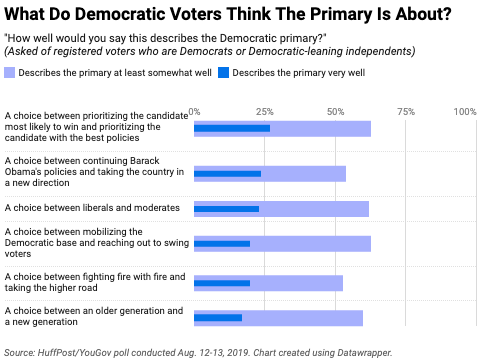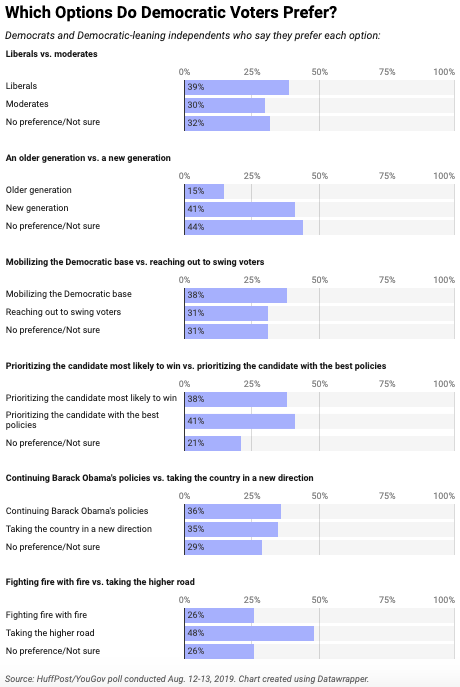
Primary elections have a way of highlighting a party’s fault lines. Over the past few months, Democratic candidates have been publicly debating everything from single-payer “Medicare for All” to the need for generational change.
Last December, in the afterglow of the 2018 midterms, 62% of Democrats and Democratic-leaning voters said the party was more united than divided. By this July, that number had sunk nearly 20 points. And Democrats are plenty divided about what exactly is dividing them, according to a new HuffPost/YouGov poll.
Some of the most obvious divides are demographic. Former Vice President Joe Biden, the race’s early front-runner, posts his best numbers among Black voters, people over age 44 and people without college degrees; he has less traction among white and college-educated voters, and struggles especially with younger voters.
Other divides are ideological. The party, while increasingly liberal, still encompasses many self-described moderates. Democrats broadly agree on plenty of issues, but there are also concrete divides on everything from health care to immigration.
Alongside those cleavages, the early stages of the campaign have also been dogged by a sense that the party is facing some sort of crucial, if nebulous, philosophical schism: the importance of ”electability,” maybe, or the best way of addressing President Barack Obama’s legacy, or the right tone to take against President Donald Trump, or the endless debate over whether campaigns should focus more on mobilizing the base or coaxing back swing voters.
Many of these binaries effectively serve as ways to pit Biden ― an older candidate who’s based his appeal around his ties to Obama and his perceived ability to win ― against the rest of the field. But they also reflect larger questions about the ideological direction of the party, and the approach Democrats should take to winning in 2020 and beyond.
To get a better sense of the Democratic electorate, we asked Democratic and Democratic-leaning voters about six of these questions in a new HuffPost/YouGov survey, testing their preferences on topics including ideology, generational politics and strategy.
But posing these choices inherently risks making assumptions about how those voters view the race ― whether these are distinctions that particularly matter to them, or ones they’d even make if they weren’t being prompted by pollsters. So we also asked voters how well they thought each of these choices defined the campaign.
Each of the contrasts we asked about was described by a slim majority of voters ― between 53% and 63% ― as defining the primary at least “somewhat well,” with the frames about tone and the Obama presidency garnering modestly less support than the others. Even fewer voters thought any one option fit the race “very well,” ranging from the 17% who thought that the framing of the race as a generational choice was very fitting to the 27% who saw the electability argument as being definitional.

Those results suggest that, while voters do see real philosophical divides on how the Democratic Party should approach 2020, they don’t necessarily perceive the election as a referendum on any one key fracture ― or, at least, not any of the ones included in this survey.
The poll also asked Democratic and Democratic-leaning voters which of the options, if either, they favored for each question. They preferred a new generation by 26 points, a “take the high road” approach by 22 points, liberal ideology by 9 points and a strategy focused on mobilizing the base by 7 points. Opinions were within 4 points of evenly split on Obama’s legacy and the importance of electability. On each question, a fifth or more weren’t sure or said they didn’t really have a preference.
(Two important caveats here: First, responses can vary considerably based on how exactly these choices are framed. Other polling, for example, has often found voters placing far more of a premium on electability. And second: Rather than picking their favorite candidate based on the philosophies they represent, voters may instead gravitate toward the standpoints or traits that reflect the candidates they already support.)

Broadly, the results raise doubts about whether voters are treating any of the questions as clear road maps for deciding which candidates to back. Two attributes for which voters show the strongest preferences ― a new generation, and a “higher road” ― don’t quite line up with the horserace polling so far.
Older candidates may not be winning voters on the basis of their age, but it doesn’t seem to have notably hurt them, either. Biden, Sen. Bernie Sanders (I-Vt.) and Sen. Elizabeth Warren (D-Mass.), the three oldest candidates in the race, are the three current front-runners. And voters seemingly have yet to punish any candidate for taking too aggressive a tone against Trump.
In other words, there’s probably no set of clear primary “lanes,” ideological or otherwise, for voters to follow as they narrow down their list of candidates. Instead, there’s a cavalcade of often competing priorities. That’s borne out by data on whom voters are actually considering, which often fails to follow any easily discernible patterns.
“A reliable rule of thumb about nomination politics is that when voters are required to make an electoral choice among multiple candidates within the same party, their preferences will be relatively weak, unpredictable, based on limited information, and open to change up until the moment they cast their ballot,” political scientist David Hopkins wrote earlier this year.
“It can be easy to impose a clever and plausible-sounding analytical structure on the process in advance, or to explain in retrospect why one candidate won more support than another,” Hopkins wrote. “But in the midst of the action, there is plenty about nominations that resists straightforward interpretation or forecasting. And the larger the field of contenders, the more complicated things get.”
You can further explore the results of the HuffPost/YouGov survey with this interactive widget, using the menu at the top to select survey questions and the buttons at the bottom to filter the data by subgroups.
The HuffPost/YouGov poll consisted of 1,000 completed interviews conducted Aug. 12-13 among U.S. adults, using a sample selected from YouGov’s opt-in online panel to match the demographics and other characteristics of the adult U.S. population.
HuffPost has teamed up with YouGov to conduct daily opinion polls. You can learn more about this project and take part in YouGov’s nationally representative opinion polling. More details on the polls’ methodology are available here.
Most surveys report a margin of error that represents some but not all potential survey errors. YouGov’s reports include a model-based margin of error, which rests on a specific set of statistical assumptions about the selected sample rather than the standard methodology for random probability sampling. If these assumptions are wrong, the model-based margin of error may also be inaccurate. Click here for a more detailed explanation of the model-based margin of error.
